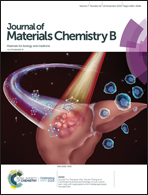Smart textiles in wound care: functionalization of cotton/PET blends with antimicrobial nanocapsules†
Abstract
Management of infected wounds is one of the most costly procedures in the health care sector. Burn wounds are of significant importance due to the high infection risk that can possibly lead to severe consequences such as sepsis. Because antibiotic wound treatments have caused increasing antibiotic resistance in bacteria, there is currently a strong need for alternative strategies. Therefore, we developed new antimicrobial wound dressings consisting of pH-responsive human serum albumin/silk fibroin nanocapsules immobilized onto cotton/polyethylene terephthalate (PET) blends loaded with eugenol, which is an antimicrobial phenylpropanoid. Ultrasound-assisted production of eugenol-loaded nanocapsules resulted in particle sizes (hydrodynamic radii) between 319.73 ± 17.50 and 574.00 ± 92.76 nm and zeta potentials ranging from −10.39 ± 1.99 mV to −12.11 ± 0.59 mV. Because recent discoveries have indicated that the sweat glands contribute to wound reepithelialisation, release studies of eugenol were conducted in different artificial sweat formulas that varied in pH. Formulations containing 10% silk fibroin with lower degradation degree exhibited the highest release of 41% at pH 6.0. After immobilization, the functionalized cotton/PET blends were able to inhibit 81% of Staphylococcus aureus and 33% of Escherichia coli growth. Particle uniformity, silk fibroin concentration, and high surface-area-to-volume ratio of the produced nanocapsules were identified as the contributing factors leading to high antimicrobial activities against both strains. Therefore, the production of antimicrobial textiles using nanocapsules loaded with an active natural compound that will not contribute to antibiotic resistance is seen as a potential future alternative to commercially available antiseptic wound dressings.



 Please wait while we load your content...
Please wait while we load your content...